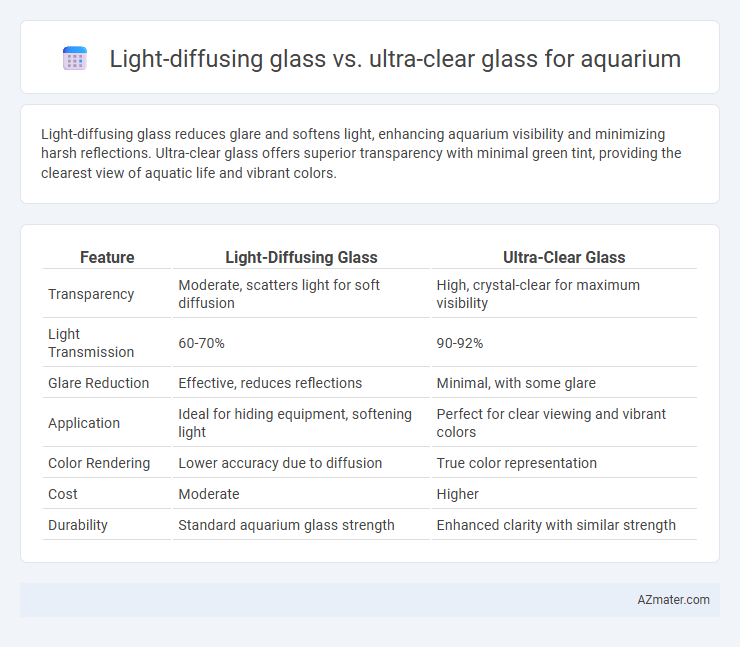Light-diffusing glass reduces glare and softens light, enhancing aquarium visibility and minimizing harsh reflections. Ultra-clear glass offers superior transparency with minimal green tint, providing the clearest view of aquatic life and vibrant colors.
Table of Comparison
| Feature | Light-Diffusing Glass | Ultra-Clear Glass |
|---|---|---|
| Transparency | Moderate, scatters light for soft diffusion | High, crystal-clear for maximum visibility |
| Light Transmission | 60-70% | 90-92% |
| Glare Reduction | Effective, reduces reflections | Minimal, with some glare |
| Application | Ideal for hiding equipment, softening light | Perfect for clear viewing and vibrant colors |
| Color Rendering | Lower accuracy due to diffusion | True color representation |
| Cost | Moderate | Higher |
| Durability | Standard aquarium glass strength | Enhanced clarity with similar strength |
Introduction: Choosing the Right Glass for Aquariums
Light-diffusing glass enhances aquarium aesthetics by softening light and reducing glare, creating a blurred background effect that emphasizes tank inhabitants. Ultra-clear glass offers superior transparency with minimal green tint, providing vibrant and true-to-life colors for viewing aquatic life. Selecting between these glasses depends on the desired visual clarity and decorative impact within the aquarium environment.
What is Light-Diffusing Glass?
Light-diffusing glass is designed to scatter incoming light evenly, reducing glare and hotspots in aquariums to promote balanced illumination for aquatic plants and animals. Unlike ultra-clear glass, which maximizes transparency and minimizes visual distortion, light-diffusing glass enhances light distribution by dispersing light rays through microscopic surface textures or embedded particles. This feature supports healthier photosynthesis in aquatic plants by ensuring uniform light penetration throughout the tank environment.
What is Ultra-Clear Glass?
Ultra-clear glass, often referred to as low-iron glass, contains significantly reduced iron content compared to standard light-diffusing glass, resulting in higher transparency and enhanced clarity for aquarium displays. This type of glass eliminates the greenish tint common in regular glass, providing more vibrant and accurate color representation of aquatic life and underwater landscapes. Its superior optical properties make it ideal for high-end aquariums where visual impact and detail are paramount.
Visual Clarity: Comparing Transparency Levels
Light-diffusing glass for aquariums scatters incoming light to reduce glare and soften reflections, resulting in a slightly hazy appearance that can diminish overall transparency. Ultra-clear glass features higher purity and lower iron content, providing superior light transmission with minimal color distortion and maximum visual clarity. This makes ultra-clear glass ideal for aquariums where vivid, lifelike viewing experiences are prioritized, while light-diffusing glass may be chosen for aesthetic softness and reduced eye strain.
Light Distribution: Effects on Aquatic Environment
Light-diffusing glass evenly scatters incoming light, minimizing harsh shadows and promoting uniform illumination in aquariums, which supports balanced photosynthesis for aquatic plants and healthier coral growth. Ultra-clear glass maximizes light transmission with minimal distortion, enhancing clarity and color vibrancy but may create intense light spots that can stress sensitive species. Choosing between these glasses depends on desired light quality: diffusing glass for stable, consistent light distribution that fosters a harmonious aquatic environment, or ultra-clear glass for maximum visibility and brightness with careful light management.
Color Enhancement: Fish and Plant Appearance
Light-diffusing glass enhances aquarium visuals by softening and evenly distributing light, which intensifies the natural coloration of fish and plants, making colors appear more vivid and reducing harsh reflections. Ultra-clear glass offers superior transparency with minimal tint, allowing true-to-life colors to shine through, ideal for showcasing brightly colored fish and vibrant plant life without distortion. Selecting between the two depends on whether the emphasis is on softened, balanced lighting effects or maximum color clarity and brightness in aquarium displays.
Durability and Maintenance Differences
Light-diffusing glass for aquariums offers enhanced durability due to its ability to resist scratches and minimize glare, reducing the need for frequent cleaning or maintenance. Ultra-clear glass provides superior optical clarity but is generally more prone to showing scratches and water stains, requiring more regular upkeep to maintain its pristine appearance. Both types demand routine maintenance, but light-diffusing glass typically offers a lower-maintenance solution with longer-lasting aesthetic and functional performance.
Cost Comparison: Light-Diffusing vs Ultra-Clear Glass
Light-diffusing glass typically costs 15-25% more than ultra-clear glass due to specialized manufacturing processes that create enhanced light diffusion properties. Ultra-clear glass remains the more economical option, offering high transparency with lower production expenses, making it suitable for budget-conscious aquarium builders. The choice between these glass types hinges on balancing cost with desired visual effects and lighting performance in aquarium applications.
Pros and Cons of Light-Diffusing Glass in Aquariums
Light-diffusing glass in aquariums disperses light evenly, reducing harsh reflections and glare, which enhances viewing comfort and promotes balanced plant growth by distributing light across the tank. However, this diffusion can slightly diminish overall light intensity, potentially limiting brightness and affecting photosynthetic efficiency for certain light-demanding aquatic species. Unlike ultra-clear glass, which offers maximum transparency and clarity, light-diffusing glass may obscure fine details but provides a softer, more natural visual effect beneficial for creating calming aquarium aesthetics.
Pros and Cons of Ultra-Clear Glass in Aquariums
Ultra-clear glass in aquariums offers superior clarity and color accuracy, enhancing the viewing experience by minimizing greenish tint found in standard glass. Its increased thickness and higher iron content provide improved strength and durability but come at a slightly higher cost compared to light-diffusing glass. However, ultra-clear glass may also increase glare and reflections, potentially affecting visibility under certain lighting conditions.

Infographic: Light-diffusing glass vs Ultra-clear glass for Aquarium
 azmater.com
azmater.com